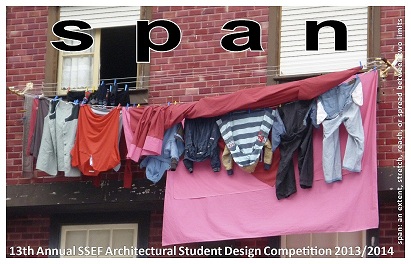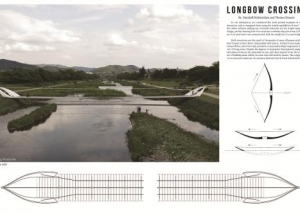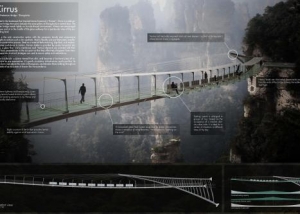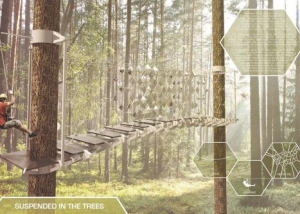2013- 2014
Finalists
Project Title | Student(s) | University | Faculty Sponsor(s) | Award |
| Suspended in the Trees | Angela Ng | Ryerson University | Mark Cichy | Award of Excellence |
| Cirrus Wang | Mark Weiyi | University of Waterloo | Terri Meyer Boake | Award of Merit |
| Longbow Crossing | Thomas Noussis & Marshall Mykietyshyn | University of Waterloo | Terri Meyer Boake & Matthew Spremulli | Award of Merit |
| SHIFT: Pavilion I Bridge | Min Joon (Jeff) Jang & Roger Xu | Ryerson University | Vincent Hui | Top 10 |
| The Esoteric Harp | Karam Hunjan & Ethan Schwartz | University of Waterloo | Terri Meyer Boake & Matthew Spremulli | Top 10 |
| “Span” | Di Wang & Alexandru Vilcu & Richard Mui | University of Waterloo | Terri Meyer Boake | Top 10 |
| Elevated Field | Elaina Poleto & Keegan Steeper & Thomas Yuan | University of Waterloo | Terri Meyer Boake | Top 10 |
| Concentric Bridge | Timothy Melnichuk | Ryerson University | Mark Cichy | Top 10 |
| Rouge River Pedestrian Bridge | Ron Noble | Ryerson University | Mark Cichy | Top 10 |
| VIEW POINT | Anusha Ramesh | Ryerson University | Mark Cichy | Top 10 |
Judging Panel
Holly Jordan – B+H Architects
Gerry Lang – architectsAlliance
Neb Erakovic – CH2M Hill Canada Limited
Tim Verhey – Walters Inc.
The Challenge
Historically, the ability of materials to span has challenged architectural design. Stone, wood, concrete and metals were limited by their own self-weight, as well as their capacity to resist bending stresses. As more advanced designs such as arches, domes and trusses were developed, greater spans were achieved, but self-weight and structural depth continued pose challenges. As engineering and design advanced, the complexities of spanning were brought into harmony through the development of new forms and material. For example, metallurgical advancements in structural steel enabled spans that were unthinkable a century ago.
While engineering has led to the conquering of ever-increasing spans, the real benefit of advanced engineering principles and material science is reflected not so much in greater distances as the unleashing of architectural imagination. Brute muscle has been replaced by finely tuned compositions that intertwine tension and compression in highly refined forms. Strategies such as stressed skins, honeycombed cells and diagrids have led designers to the precipice not only of mimicking the engineering marvels that took nature untold millennia to achieve, but to the point where we dare dream of outperforming even her. Yet despite the wonders of computer-driven engineering solutions to achieve the resolution of spans in ways we never dreamed possible, can’t the simplistic beauty of an elegant solution ever truly be overlooked?
The challenge offered by this year’s competition is to explore span – not only by pushing the limits of imagination, but also by re-examining the purity and simplicity that architecture has engaged since time immemorial.
Competition Statement
The intention of this design competition is primarily to provide students of architecture in Canada with a unique opportunity: to enter into a design process that brings together, of necessity, concept and reality. It is important for students of architecture to grasp the fact that structural design lies not just in the realm of the engineer, but can be a means for architects of arriving at a meaningful realization of architectural ideas. It is when theory meets physical necessity that architecture can become really interesting.
To that end, this competition calls upon students to conceptualize, and realize in detail, a structure of simple program that explores span. The exploration will, of course, include issues related to program and site, but the emphasis in this competition is upon the architectural exploration through form and material, on the essential relationship between architecture and structure.
The reality of this competition comes in two forms: through the requirement for buildable details, primarily utilizing structural steel; and through the collaboration with the steel fabrication industry on those details. This collaboration is an important component of this competition, as a secondary objective is to expose students to both the opportunities and restraints inherent in realizing conceptual design.
The conceptual component of this competition will come through the recommendation that this competition be run through either a studio, or a lecture based course, most probably within a structures course. Under the guidance of faculty sponsors, students will conduct the design process as an academic exercise, within the guidelines set out in this brief. As an academic project, the design process will adhere to the standards set forth by the students’ school of architecture.




